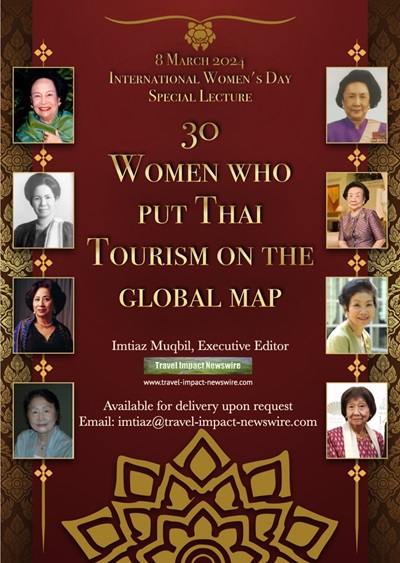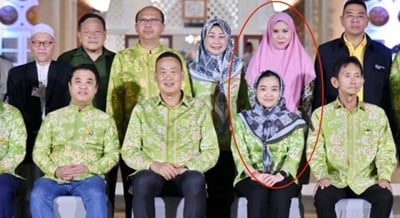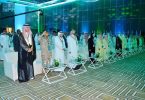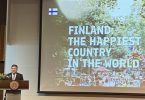The two Thai women in the red oval frame are Ms. Sudawan Wangsuphakijkosol, Minister of Tourism and Sports (seated), and Mrs. Thapanee Kiatphaibool, Governor of the Tourism Authority of Thailand (standing behind). Between February 27-29, 2024, both accompanied Thai Prime Minister Srettha Thavisin on a high-powered “Peace Through Tourism” visit to the Muslim-majority provinces of Yala, Pattani and Narathiwat in South Thailand.
As far as I know, Thailand is the only country where both the two top leaders of the tourism industry are women. That says a lot about Thailand’s leadership in the area of Gender Equality (UN Sustainable Development Goad #5).
The hijab is a traditional attire worn by many Muslim women worldwide. So, when the two Thai tourism leaders visited South Thailand, they followed the dictum, “When in Rome, do as the Romans do.”
They sent a powerful message to the Thai-Muslim women of South Thailand, especially the emerging young generation, that the Thai tourism industry sees Thai-Muslims as being valuable contributors to nation-building, peace and human development in that geostrategically critical part of the kingdom.
In one priceless action, they met many of the UN Sustainable Development Goals.
Today, there is a close correlation between Thai foreign policy and tourism policy. The Ministry of Foreign Affairs is leading the charge with a strategy termed “Proactive Economic Diplomacy”, which means expanding Thailand’s “soft power” brand image, opening markets for Thai entrepreneurs, removing visa restrictions for Thais travelling abroad, and more.
The Thais are well aware of the negative consequences of ethnic strife involving minority populations. They have seen what happened for years in two other Buddhist-majority countries, Sri Lanka and Myanmar.
No country is immune to conflict stemming from social, cultural and ethnic grievances and injustice.
Muslims comprise roughly 12% of the overall Thai population. In South Thailand, however, they comprise the majority of the local population in Yala, Narathiwat and Pattani.
For several decades, those provinces have been hit by ethnic and sectarian strife due to a range of reasons that are beyond the scope of this article. The result was the same as Sri Lanka and Myanmar — economic stagnation, loss of tourism and jobs.
But times they are a-changing. The emerging young generation of Thai Muslims sees great business and economic prospects ahead and wants to take advantage of them via rapidly growing forums like the Thai Muslim Trade Association (TMTA).
Recognizing that demographic shift, the Thai Foreign Ministry is helping them do exactly that. Building relations with the Islamic world is a critical component. Thanks to the efforts of the late Dr Surin Pitsuwan, Thailand’s first Muslim Foreign Minister, Thailand has observer status in the Organization of Islamic Countries (OIC).
In January 2022, Thailand and Saudi Arabia, respectively the two leading Buddhist- and Muslim-majority kingdoms, ended a 32-year diplomatic and economic rift. Today, just two years later, bilateral travel, trade and transport linkages have skyrocketed.

Thailand is a founder member of ASEAN and maintains strong relations with its Muslim-majority colleague members Indonesia, Malaysia and Brunei Darussalaam. It also works with Muslim-majority countries in the neighborhood via sub-regional groupings such as the Indonesia-Malaysia-Thailand Growth Triangle (IMT-GT) and Bangladesh Bhutan Nepal India Myanmar Sri Lanka Thailand Economic Cooperation (BIMSTEC).
Bilaterally, Thailand and Malaysia share a 650-kilometer land border and have extensive social, cultural and economic linkages, via nine overland and maritime crossings. Today, Malaysians are the second largest source of visitor arrivals for Thailand, after China.
The Prime Minister’s Feb 27-29 visit to South Thailand was designed to advance relations across all fronts. This objective can only succeed if there is buy-in from the local population, the local ethnic communities are free of strife and the Government shows that its leaders respect the local cultures.
Peace is the most important of the 5Ps of the UN Sustainable Development Goals (Peace, Planet, Prosperity, Partnerships and People).
Thailand’s tourism success over the years is because it is truly an Alliance of Civilizations destination. Millions of people worship at the Erawan shrine in downtown Bangkok. Christmas, Chinese New Year and Songkran are all celebrated with equal gusto.
Its contribution to jobs and economic revival has made Travel & Tourism a key component of political survival and national security. That means preserving the peace. That, in turn, means respecting the minorities and including them in the nation-building effort.
By donning the hijab, even if for just a photo-op, that is exactly what the two Thai tourism women leaders did.
It was a symbolic gesture, but it meant a lot. And it will gain even more value if the private sector business community follows suit, especially in the upcoming fasting month of Ramadan, the most important part of the Islamic calendar, and the holiday period which follows.
In an era when geopolitical conflict has become the leading threat to the future of humanity, the Travel & Tourism industry, the so-called Industry of Peace, can learn a lot from that.
Read the original article here.
(eTN): Thai Tourism Women Leaders Set Example for Peace | re-post license | post content























